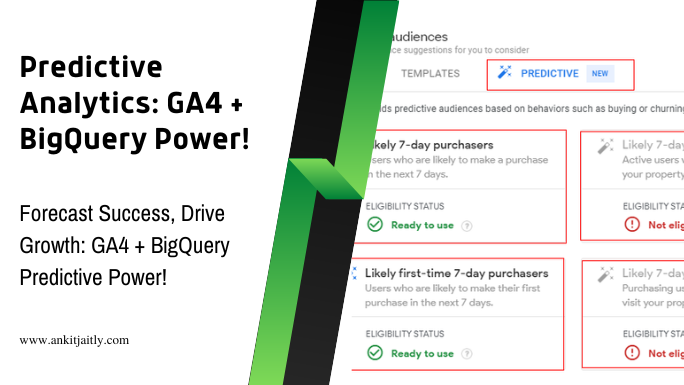In today’s rapidly evolving digital landscape, companies are constantly seeking innovative ways to gain deeper insights into their customers and products. With the integration of BigQuery and Google Analytics 4, businesses are able to harness the power of predictive analytics to anticipate trends and make data-driven decisions. By leveraging the advanced capabilities of BigQuery with the rich data from Google Analytics 4, companies can unlock valuable information that enables them to forecast future behaviors and outcomes with unprecedented accuracy.
Through this guide, we will delve into the benefits of utilizing BigQuery with Google Analytics 4 for predictive analytics, the potential pitfalls to avoid, and the best practices for implementing this powerful combination to drive business growth. Stay tuned as we explore the strategies and techniques that companies are using to stay ahead in the competitive market through predictive analytics.
Understanding Predictive Analytics
The use of predictive analytics involves the process of predicting future outcomes based on historical data and analytical techniques such as statistical algorithms and machine learning models. This process is used by companies to gain insights into potential future events and trends, allowing them to make more informed decisions and take proactive measures.
// Sample code for predictive analytics using Python
import pandas as pd
from sklearn.model_selection import train_test_split
from sklearn.linear_model import LogisticRegression
from sklearn.metrics import accuracy_score
# Code for data preprocessing
data = pd.read_csv('data.csv')
# Code for model training
X_train, X_test, y_train, y_test = train_test_split(X, y, test_size=0.2, random_state=42)
model = LogisticRegression()
model.fit(X_train, y_train)
# Code for model evaluation
y_pred = model.predict(X_test)
accuracy = accuracy_score(y_test, y_pred)
Types of Predictive Analytics Models
There are several types of predictive analytics models that companies can utilize, including:
- Regression Models – Used for predicting continuous numerical values based on input variables.
- Classification Models – Used for predicting categories or classes based on input variables.
- Clustering Models – Used for identifying natural groupings within data.
- Time Series Analysis – Used for forecasting future values based on historical time-based data.
- Machine Learning Models – Utilize algorithms to learn from data and make predictions.
# Sample code for regression model training
from sklearn.linear_model import LinearRegression
model = LinearRegression()
model.fit(X_train, y_train)
Factors Influencing Predictive Analytics
Types of data, data quality, and the choice of analytical techniques are fundamental factors influencing predictive analytics. Companies must have access to comprehensive and reliable data, encompassing various aspects such as customer behavior, market trends, and operational performance. Knowing how to interpret and utilize this data is essential for building accurate predictive models.
# Sample code for data preprocessing
from sklearn.preprocessing import StandardScaler
scaler = StandardScaler()
X_train_scaled = scaler.fit_transform(X_train)
X_test_scaled = scaler.transform(X_test)
- Data Quality – Ensuring the accuracy and completeness of data is crucial for reliable predictions.
- Analytical Techniques – Choosing the appropriate algorithms and models based on the nature of the data and the prediction task.
- Interpretation of Data – Understanding the insights derived from data and translating them into actionable strategies.
- Accuracy of Predictive Models – Evaluating the performance and reliability of predictive models through rigorous testing and validation.
- Business Impact – Recognizing the potential impact of predictive analytics on business operations and strategies.
Integrating BigQuery with Google Analytics 4
Any company looking to leverage the power of predictive analytics with Google Analytics 4 can benefit from integrating BigQuery with the platform. This integration allows businesses to analyze and process large volumes of data from multiple sources, enabling them to gain valuable insights and make informed decisions to drive growth and success.
// Sample code for integrating BigQuery with Google Analytics 4
const { BigQuery } = require('@google-cloud/bigquery');
const bigQuery = new BigQuery();
Step-by-Step Guide to Integration
Analytics integration is a straightforward process that can be accomplished in a few simple steps. First, set up a BigQuery project in the Google Cloud Console. Then, link your Google Analytics 4 property to BigQuery, allowing data to flow seamlessly between the two platforms.
Finally, configure the data stream from Google Analytics 4 to BigQuery, ensuring that the relevant data is captured and stored for analysis and reporting.
// Sample code for configuring the data stream from Google Analytics 4 to BigQuery
const { DataTransferServiceClient } = require('@google-cloud/bigquery-data-transfer');
const dataTransferServiceClient = new DataTransferServiceClient();
| Google Cloud Console | Set up a BigQuery project |
| Google Analytics 4 | Link property to BigQuery |
| Data Stream Configuration | Configure data flow from GA4 to BigQuery |
Tips for Effective Data Management
Effective data management is crucial for maximizing the benefits of integrating BigQuery with Google Analytics 4. To ensure smooth operations, businesses should regularly audit their data sources and optimize data models for efficient processing and analysis. Additionally, establishing data governance and access controls can help maintain data integrity and security.
// Sample code for optimizing data models in BigQuery
const { Table } = require('@google-cloud/bigquery');
const table = new Table();
- Data Audit: Regularly review data sources
- Data Optimization: Optimize data models for efficient processing
- Data Governance: Establish governance and access controls
It is important for companies to prioritize effective data management practices to ensure the accuracy, reliability, and security of their data, ultimately leading to more robust predictive analytics and strategic decision-making.
// Sample code for establishing data access controls in BigQuery
const { Dataset } = require('@google-cloud/bigquery');
const dataset = new Dataset();
- Data Audit: Regularly review data sources
- Data Optimization: Optimize data models for efficient processing
- Data Governance: Establish governance and access controls
Applying Predictive Analytics in Business
For companies looking to gain a competitive edge, the application of predictive analytics in business can be a game-changer. By leveraging data from Google Analytics 4 and BigQuery, companies can harness the power of predictive analytics to forecast future trends, make data-driven decisions, and optimize their business strategies.
// Example code for applying predictive analytics
SELECT
predicted_clicks,
DATE
FROM
predictions_table
WHERE
DATE = '2023-01-01';
Pros and Cons of Predictive Analytics Adoption
Pros
| Pros | Cons |
| Identifying new business opportunities | Complex implementation process |
| Improving marketing and sales effectiveness | Dependence on quality data |
| Enhancing customer satisfaction | Potential privacy concerns |
// Example code for pros and cons of predictive analytics adoption
SELECT
business_opportunities,
marketing_effectiveness,
customer_satisfaction
FROM
predictive_analytics_results;
Real-World Examples of Predictive Insights
On a practical level, companies have utilized predictive insights to personalize customer experiences, forecast demand, and optimize inventory management. For example, e-commerce companies have used predictive analytics to recommend products to customers based on their browsing behavior, leading to increased sales and customer satisfaction.
// Example code for real-world examples of predictive insights
SELECT
personalized_recommendations,
demand_forecasts,
inventory_optimization
FROM
predictive_insights_results;
Consistently leveraging predictive insights can lead to a significant competitive advantage, but it’s important for companies to carefully consider the potential risks and limitations. Consistency in data quality, managing privacy concerns, and the complexity of implementation are some of the challenges that companies may encounter when adopting predictive analytics.
// Example code for cons of predictive insights
SELECT
data_quality_consistency,
privacy_management,
implementation_complexity
FROM
predictive_insights_challenges;
How Can BigQuery and Google Analytics 4 Work Together for Predictive Analytics in Companies?
By leveraging google analytics 4 integration with bigquery, companies can merge their web and app data to identify patterns, trends, and customer behavior. This collaboration allows for predictive analytics, enabling businesses to make strategic decisions based on valuable insights derived from their data.
Optimizing Predictive Analytics with BigQuery
After integrating Google Analytics 4 with BigQuery, companies can take advantage of the platform’s powerful features to optimize their predictive analytics. By leveraging BigQuery’s massive storage and processing capabilities, data analysts can enhance the performance and accuracy of their predictive models.
# Create a materialized view for faster querying
CREATE MATERIALIZED VIEW my_dataset.sales_mv
AS
SELECT product_id,
SUM(sale_amount) AS total_sales
FROM my_dataset.sales
GROUP BY product_id;
Advanced Techniques for Data Analysts
On top of basic predictive analytics, data analysts can employ advanced techniques to further refine their models. These techniques include building custom machine learning models, leveraging natural language processing for unstructured data, and implementing deep learning algorithms for complex patterns recognition.
# Train a custom machine learning model using BigQuery ML
CREATE OR REPLACE MODEL my_dataset.customer_segmentation
OPTIONS(model_type='kmeans',
num_clusters=5) AS
SELECT *
FROM my_dataset.customer_data;
- Custom Machine Learning Models
- Natural Language Processing
- Deep Learning Algorithms
Tips for Improving Predictive Model Accuracy
Data analysts can take specific steps to improve the accuracy of their predictive models. This includes feature engineering, hyperparameter tuning, cross-validation, and ensemble learning techniques. By implementing these tips, companies can ensure their predictive models are more reliable and precise in their forecasts.
# Use hyperparameter tuning to find the best parameters for a model
SELECT *
FROM ML.HYPERPARAMETER_TUNING(MODEL my_dataset.customer_churn_model)
- Feature Engineering
- Hyperparameter Tuning
- Cross-Validation
- Ensemble Learning Techniques
- Perceiving the Key Patterns and Insights
Further enhancing the predictive model accuracy involves continuously refining the data inputs, optimizing the model parameters, and monitoring its performance over time. By iterating on these processes, data analysts can achieve strong predictive model accuracy and reliability for informed business decision-making.
# Monitor the performance of a predictive model over time
SELECT *
FROM ML.EVALUATE(MODEL my_dataset.customer_churn_model,
(SELECT * FROM my_dataset.customer_data WHERE datediff('2023-01-01', registration_date) <= 365));
- Data Inputs Refinement
- Model Parameters Optimization
- Performance Monitoring
- Perceiving the Patterns and Insights
Conclusion
With this in mind, it is evident that companies are leveraging BigQuery with Google Analytics 4 to harness the power of predictive analytics. By integrating these two powerful tools, organizations can gain valuable insights into customer behavior, trends, and preferences, allowing them to make informed decisions and drive business growth. Through the use of machine learning and advanced data analysis, companies can proactively identify potential opportunities and risks, optimize marketing strategies, and enhance overall performance. With the abundance of data available in today’s digital landscape, the combination of BigQuery and Google Analytics 4 provides businesses with the tools they need to stay ahead of the competition and thrive in the ever-evolving market.


Leave a Reply